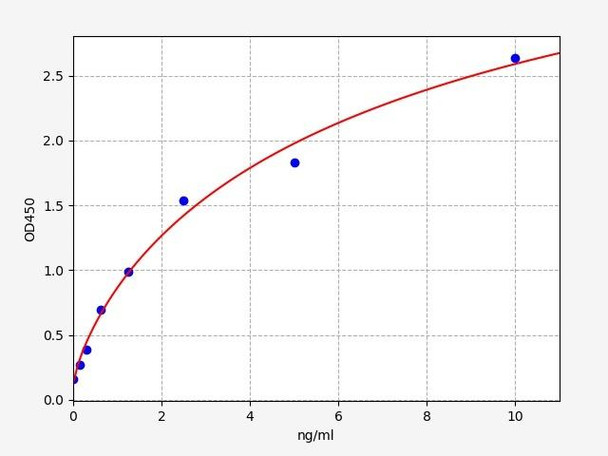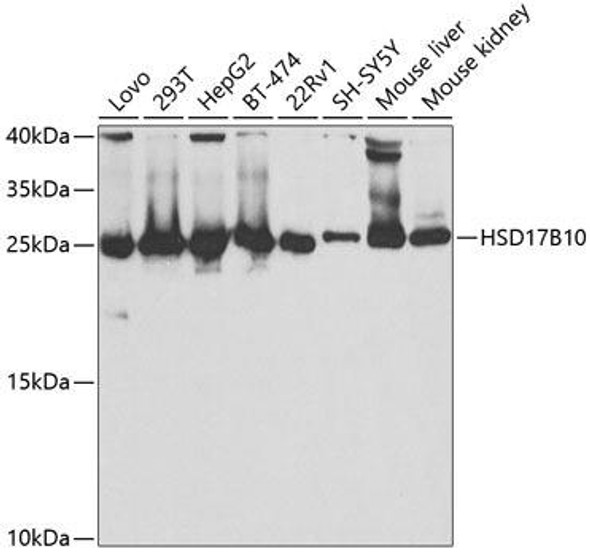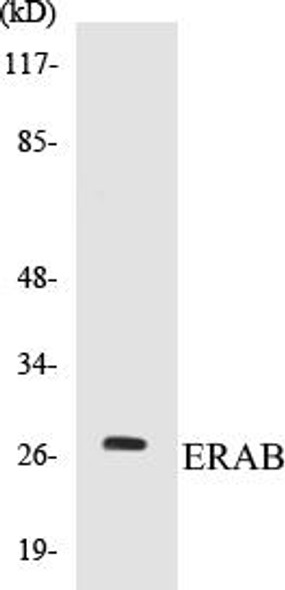Human HSD17B10 / ERAB ELISA Kit (HUFI01978)
- SKU:
- HUFI01978
- Product Type:
- ELISA Kit
- Size:
- 96 Assays
- Uniprot:
- Q99714
- Sensitivity:
- 0.094ng/ml
- Range:
- 0.156-10ng/ml
- ELISA Type:
- Sandwich
- Synonyms:
- HSD17B10, 17-beta-hydroxysteroid dehydrogenase 10, 17-beta-HSD 10, 3-hydroxy-2-methylbutyryl-CoA dehydrogenase, 3-hydroxyacyl-CoA dehydrogenase type
- Reactivity:
- Human
- Research Area:
- Epigenetics and Nuclear Signaling
Description
Human HSD17B10/ERAB ELISA Kit
The Human HSD17B10/ERAB ELISA Kit is specifically designed for the accurate quantification of HSD17B10/ERAB levels in human serum, plasma, and cell culture supernatants. This kit offers high sensitivity and specificity, ensuring precise and reproducible results for a variety of research applications.HSD17B10/ERAB is an enzyme that plays a crucial role in various metabolic pathways, including fatty acid oxidation and steroid hormone metabolism. Dysregulation of HSD17B10/ERAB has been linked to metabolic disorders, neurodegenerative diseases, and certain types of cancer, making it a valuable biomarker for studying these conditions and potentially identifying novel therapeutic targets.
With the Human HSD17B10/ERAB ELISA Kit, researchers can confidently measure HSD17B10/ERAB levels in biological samples, providing valuable insights into its molecular mechanisms and potential implications for human health. Get accurate and reliable results with this advanced ELISA kit from AssayGenie.
| Product Name: | Human HSD17B10 / ERAB ELISA Kit |
| Product Code: | HUFI01978 |
| Size: | 96 Assays |
| Alias: | HSD17B10, 17-beta-hydroxysteroid dehydrogenase 10, 17-beta-HSD 10, 3-hydroxy-2-methylbutyryl-CoA dehydrogenase, 3-hydroxyacyl-CoA dehydrogenase type |
| Detection method: | Sandwich ELISA, Double Antibody |
| Application: | This immunoassay kit allows for the in vitro quantitative determination of Human HSD17B10 concentrations in serum plasma and other biological fluids. |
| Sensitivity: | 0.094ng/ml |
| Range: | 0.156-10ng/ml |
| Storage: | 4°C for 6 months |
| Note: | For Research Use Only |
| Recovery: | Matrices listed below were spiked with certain level of Human HSD17B10 and the recovery rates were calculated by comparing the measured value to the expected amount of Human HSD17B10 in samples. | ||||||||||||||||
| |||||||||||||||||
| Linearity: | The linearity of the kit was assayed by testing samples spiked with appropriate concentration of Human HSD17B10 and their serial dilutions. The results were demonstrated by the percentage of calculated concentration to the expected. | ||||||||||||||||
| |||||||||||||||||
| CV(%): | Intra-Assay: CV<8% Inter-Assay: CV<10% |
| Component | Quantity | Storage |
| ELISA Microplate (Dismountable) | 8×12 strips | 4°C for 6 months |
| Lyophilized Standard | 2 | 4°C/-20°C |
| Sample/Standard Dilution Buffer | 20ml | 4°C |
| Biotin-labeled Antibody(Concentrated) | 120ul | 4°C (Protect from light) |
| Antibody Dilution Buffer | 10ml | 4°C |
| HRP-Streptavidin Conjugate(SABC) | 120ul | 4°C (Protect from light) |
| SABC Dilution Buffer | 10ml | 4°C |
| TMB Substrate | 10ml | 4°C (Protect from light) |
| Stop Solution | 10ml | 4°C |
| Wash Buffer(25X) | 30ml | 4°C |
| Plate Sealer | 5 | - |
Other materials and equipment required:
- Microplate reader with 450 nm wavelength filter
- Multichannel Pipette, Pipette, microcentrifuge tubes and disposable pipette tips
- Incubator
- Deionized or distilled water
- Absorbent paper
- Buffer resevoir
| Uniprot | Q99714 |
| UniProt Protein Function: | HADH2: Functions in mitochondrial tRNA maturation. Part of mitochondrial ribonuclease P, an enzyme composed of MRPP1/TRMT10C, MRPP2/HSD17B10 and MRPP3/KIAA0391, which cleaves tRNA molecules in their 5'-ends. By interacting with intracellular amyloid-beta, it may contribute to the neuronal dysfunction associated with Alzheimer disease (AD). Defects in HSD17B10 are the cause of 2-methyl-3- hydroxybutyryl-CoA dehydrogenase deficiency (MHBD deficiency). MHBD deficiency leads to neurological abnormalities, including psychomotor retardation, and, in virtually all patients, loss of mental and motor skills. Defects in HSD17B10 are the cause of mental retardation syndromic X-linked type 10 (MRXS10). MRXS10 is characterized by mild mental retardation, choreoathetosis and abnormal behavior. A chromosomal microduplication involving HSD17B10 and HUWE1 is the cause of mental retardation X-linked type 17 (MRX17); also known as mental retardation X-linked type 31 (MRX31). Mental retardation is characterized by significantly sub- average general intellectual functioning associated with impairments in adaptative behavior and manifested during the developmental period. In contrast to syndromic or specific X- linked mental retardation which also present with associated physical, neurological and/or psychiatric manifestations, intellectual deficiency is the only primary symptom of non- syndromic X-linked mental retardation. Belongs to the short-chain dehydrogenases/reductases (SDR) family. 2 isoforms of the human protein are produced by alternative splicing. |
| UniProt Protein Details: | Protein type:Mitochondrial; Oxidoreductase; EC 1.1.1.51; Amino Acid Metabolism - valine, leucine and isoleucine degradation; EC 1.1.1.35; EC 1.1.1.178 Chromosomal Location of Human Ortholog: Xp11.2 Cellular Component: mitochondrion; endoplasmic reticulum; mitochondrial matrix; mitochondrial inner membrane; cytoplasm; plasma membrane Molecular Function:3(or 17)beta-hydroxysteroid dehydrogenase activity; protein binding; 7-alpha-hydroxysteroid dehydrogenase activity; 3-hydroxy-2-methylbutyryl-CoA dehydrogenase activity; 3-hydroxyacyl-CoA dehydrogenase activity Biological Process: tRNA processing; lipid metabolic process; branched chain family amino acid catabolic process Disease: Mental Retardation, X-linked, Syndromic 10; 17-beta-hydroxysteroid Dehydrogenase X Deficiency |
| NCBI Summary: | This gene encodes 3-hydroxyacyl-CoA dehydrogenase type II, a member of the short-chain dehydrogenase/reductase superfamily. The gene product is a mitochondrial protein that catalyzes the oxidation of a wide variety of fatty acids and steroids, and is a subunit of mitochondrial ribonuclease P, which is involved in tRNA maturation. The protein has been implicated in the development of Alzheimer disease, and mutations in the gene are the cause of 17beta-hydroxysteroid dehydrogenase type 10 (HSD10) deficiency. Several alternatively spliced transcript variants have been identified, but the full-length nature of only two transcript variants has been determined. [provided by RefSeq, Aug 2014] |
| UniProt Code: | Q99714 |
| NCBI GenInfo Identifier: | 2492759 |
| NCBI Gene ID: | 3028 |
| NCBI Accession: | Q99714.3 |
| UniProt Secondary Accession: | Q99714,Q5H927, Q6IBS9, Q8TCV9, Q96HD5, |
| UniProt Related Accession: | Q99714 |
| Molecular Weight: | 261 |
| NCBI Full Name: | 3-hydroxyacyl-CoA dehydrogenase type-2 |
| NCBI Synonym Full Names: | hydroxysteroid (17-beta) dehydrogenase 10 |
| NCBI Official Symbol: | HSD17B10 |
| NCBI Official Synonym Symbols: | ABAD; CAMR; ERAB; HCD2; MHBD; HADH2; MRPP2; MRX17; MRX31; SCHAD; MRXS10; SDR5C1; 17b-HSD10; DUPXp11.22 |
| NCBI Protein Information: | 3-hydroxyacyl-CoA dehydrogenase type-2; mitochondrial RNase P subunit 2; AB-binding alcohol dehydrogenase; mitochondrial ribonuclease P protein 2; 3-hydroxy-2-methylbutyryl-CoA dehydrogenase; short chain type dehydrogenase/reductase XH98G2; amyloid-beta peptide binding alcohol dehydrogenase; short chain L-3-hydroxyacyl-CoA dehydrogenase type 2; short chain dehydrogenase/reductase family 5C, member 1; endoplasmic reticulum-associated amyloid beta-peptide-binding protein |
| UniProt Protein Name: | 3-hydroxyacyl-CoA dehydrogenase type-2 |
| UniProt Synonym Protein Names: | 17-beta-hydroxysteroid dehydrogenase 10 (EC:1.1.1.51); 17-beta-HSD 10; 3-hydroxy-2-methylbutyryl-CoA dehydrogenase (EC:1.1.1.178); 3-hydroxyacyl-CoA dehydrogenase type II; Endoplasmic reticulum-associated amyloid beta-peptide-binding protein; Mitochondrial ribonuclease P protein 2; Mitochondrial RNase P protein 2; Short-chain type dehydrogenase/reductase XH98G2; Type II HADH |
| Protein Family: | 3-hydroxyacyl-CoA dehydrogenase |
| UniProt Gene Name: | HSD17B10 |
| UniProt Entry Name: | HCD2_HUMAN |
*Note: Protocols are specific to each batch/lot. For the correct instructions please follow the protocol included in your kit.
Before adding to wells, equilibrate the SABC working solution and TMB substrate for at least 30 min at 37°C. When diluting samples and reagents, they must be mixed completely and evenly. It is recommended to plot a standard curve for each test.
| Step | Protocol |
| 1. | Set standard, test sample and control (zero) wells on the pre-coated plate respectively, and then, record their positions. It is recommended to measure each standard and sample in duplicate. Wash plate 2 times before adding standard, sample and control (zero) wells! |
| 2. | Aliquot 0.1ml standard solutions into the standard wells. |
| 3. | Add 0.1 ml of Sample / Standard dilution buffer into the control (zero) well. |
| 4. | Add 0.1 ml of properly diluted sample ( Human serum, plasma, tissue homogenates and other biological fluids.) into test sample wells. |
| 5. | Seal the plate with a cover and incubate at 37 °C for 90 min. |
| 6. | Remove the cover and discard the plate content, clap the plate on the absorbent filter papers or other absorbent material. Do NOT let the wells completely dry at any time. Wash plate X2. |
| 7. | Add 0.1 ml of Biotin- detection antibody working solution into the above wells (standard, test sample & zero wells). Add the solution at the bottom of each well without touching the side wall. |
| 8. | Seal the plate with a cover and incubate at 37°C for 60 min. |
| 9. | Remove the cover, and wash plate 3 times with Wash buffer. Let wash buffer rest in wells for 1 min between each wash. |
| 10. | Add 0.1 ml of SABC working solution into each well, cover the plate and incubate at 37°C for 30 min. |
| 11. | Remove the cover and wash plate 5 times with Wash buffer, and each time let the wash buffer stay in the wells for 1-2 min. |
| 12. | Add 90 µl of TMB substrate into each well, cover the plate and incubate at 37°C in dark within 10-20 min. (Note: This incubation time is for reference use only, the optimal time should be determined by end user.) And the shades of blue can be seen in the first 3-4 wells (with most concentrated standard solutions), the other wells show no obvious color. |
| 13. | Add 50 µl of Stop solution into each well and mix thoroughly. The color changes into yellow immediately. |
| 14. | Read the O.D. absorbance at 450 nm in a microplate reader immediately after adding the stop solution. |
When carrying out an ELISA assay it is important to prepare your samples in order to achieve the best possible results. Below we have a list of procedures for the preparation of samples for different sample types.
| Sample Type | Protocol |
| Serum | If using serum separator tubes, allow samples to clot for 30 minutes at room temperature. Centrifuge for 10 minutes at 1,000x g. Collect the serum fraction and assay promptly or aliquot and store the samples at -80°C. Avoid multiple freeze-thaw cycles. If serum separator tubes are not being used, allow samples to clot overnight at 2-8°C. Centrifuge for 10 minutes at 1,000x g. Remove serum and assay promptly or aliquot and store the samples at -80°C. Avoid multiple freeze-thaw cycles. |
| Plasma | Collect plasma using EDTA or heparin as an anticoagulant. Centrifuge samples at 4°C for 15 mins at 1000 × g within 30 mins of collection. Collect the plasma fraction and assay promptly or aliquot and store the samples at -80°C. Avoid multiple freeze-thaw cycles. Note: Over haemolysed samples are not suitable for use with this kit. |
| Urine & Cerebrospinal Fluid | Collect the urine (mid-stream) in a sterile container, centrifuge for 20 mins at 2000-3000 rpm. Remove supernatant and assay immediately. If any precipitation is detected, repeat the centrifugation step. A similar protocol can be used for cerebrospinal fluid. |
| Cell culture supernatant | Collect the cell culture media by pipette, followed by centrifugation at 4°C for 20 mins at 1500 rpm. Collect the clear supernatant and assay immediately. |
| Cell lysates | Solubilize cells in lysis buffer and allow to sit on ice for 30 minutes. Centrifuge tubes at 14,000 x g for 5 minutes to remove insoluble material. Aliquot the supernatant into a new tube and discard the remaining whole cell extract. Quantify total protein concentration using a total protein assay. Assay immediately or aliquot and store at ≤ -20 °C. |
| Tissue homogenates | The preparation of tissue homogenates will vary depending upon tissue type. Rinse tissue with 1X PBS to remove excess blood & homogenize in 20ml of 1X PBS (including protease inhibitors) and store overnight at ≤ -20°C. Two freeze-thaw cycles are required to break the cell membranes. To further disrupt the cell membranes you can sonicate the samples. Centrifuge homogenates for 5 mins at 5000xg. Remove the supernatant and assay immediately or aliquot and store at -20°C or -80°C. |
| Tissue lysates | Rinse tissue with PBS, cut into 1-2 mm pieces, and homogenize with a tissue homogenizer in PBS. Add an equal volume of RIPA buffer containing protease inhibitors and lyse tissues at room temperature for 30 minutes with gentle agitation. Centrifuge to remove debris. Quantify total protein concentration using a total protein assay. Assay immediately or aliquot and store at ≤ -20 °C. |
| Breast Milk | Collect milk samples and centrifuge at 10,000 x g for 60 min at 4°C. Aliquot the supernatant and assay. For long term use, store samples at -80°C. Minimize freeze/thaw cycles. |






